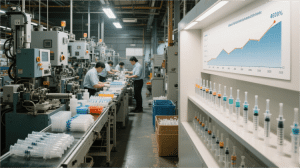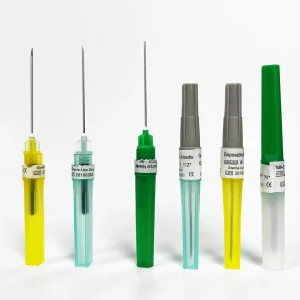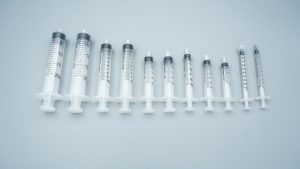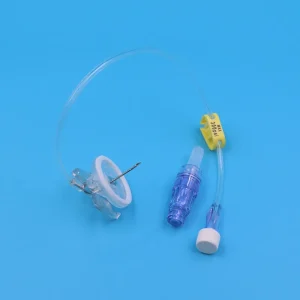In today’s healthcare landscape, safety syringes have emerged as indispensable medical devices that protect both healthcare workers and patients from preventable injuries and infections. With billions of injections administered globally each day, the transition from conventional syringes to safety syringes represents one of the most significant advances in medical device safety.
The World Health Organization reports that unsafe injection practices result in over 1.6 million infections annually, including 315,000 hepatitis B infections, 40,000 hepatitis C infections, and 4,700 HIV infections. These alarming statistics highlight why safety syringes have become essential components of modern healthcare safety equipment.
What Are Safety Syringes?
Safety syringes, also known as safety-engineered disposable sterile syringes, are advanced medical devices that incorporate multiple protection mechanisms while maintaining the basic functionality of traditional syringes. These innovative hospital safety solutions achieve automatic safety protection, reuse prevention, and ergonomic optimization through sophisticated injection safety technology.
From a technical perspective, safety syringes feature unique safety mechanism designs including:
- Automatic retraction systems
- Mechanical locking devices
- Self-destruct functions
- Tamper-resistant features
Each mechanism undergoes rigorous engineering testing and clinical validation to ensure reliable safety protection in real-world healthcare applications.
Core Advantages of Safety Syringes
1. Effective Needlestick Prevention
Needlestick prevention represents the primary benefit of modern safety syringes. Healthcare workers experience approximately 3 million needlestick injuries annually, creating physical trauma, psychological stress, and substantial economic burdens for healthcare institutions.
The severity of needlestick injuries manifests through:
Disease Transmission Risk: Hepatitis B poses the highest transmission risk at 6-30% per exposure, while hepatitis C ranges from 0.5-2%, and HIV approximately 0.3%. Safety syringes dramatically reduce these transmission risks through advanced protection mechanisms.
Economic Impact: Average processing costs per needlestick incident range from $1,000-$5,000, including post-exposure examinations, prophylactic treatment, and workers’ compensation. Safety syringes help healthcare facilities avoid these substantial costs.
Protection Systems: Modern safety syringes employ multiple protection mechanisms:
- Automatic needle retraction systems that withdraw needles in 0.1-0.3 seconds
- Needle shield systems with movable protective sleeves
- Single-hand operation designs reducing operational complexity
- Visual and audio feedback systems providing multi-sensory confirmation
2. Cross-Contamination Prevention
Traditional syringes present multiple contamination vulnerabilities that safety syringes effectively address through medical device safety innovations:
Reuse Risk Elimination: In resource-scarce regions, traditional syringe reuse occurs frequently. Safety syringes eliminate this risk through physical guarantees of single-use characteristics and self-destruct functions.
Sealed System Design: Modern safety syringes employ fully sealed systems that minimize medication contact with external environments through:
- Airtight sealing preventing contamination
- Sterile channels maintaining medication purity
- Backflow prevention design
- Advanced sterile packaging technology
Materials Innovation: Safety syringes utilize antibacterial materials and self-cleaning properties, including silver and copper ion integration for active pathogen elimination.
3. Enhanced Operational Convenience
Healthcare safety equipment must balance protection with usability. Safety syringes excel in ergonomic optimization through:
Simplified Operation: Single-hand operation systems enable healthcare workers to complete all safety functions with one hand, particularly beneficial in emergency situations or space-constrained environments.
Intuitive Interfaces: Modern safety syringes feature:
- Graphic indicators using internationally recognized symbols
- Color coding for different functional areas
- Real-time status displays
- Visual operation guidance
Intelligent Assistance: High-end safety syringes integrate smart functions including automatic medication recognition, intelligent operational reminders, and error prevention systems.
4. Significant Economic Benefits
While safety syringes typically cost 20-50% more than traditional syringes, their total lifecycle economic advantages are substantial:
Direct Cost Savings:
- Reduced medical accident processing costs
- Lower infection treatment expenses
- Decreased insurance premiums
- Avoided legal litigation costs
Return on Investment Analysis: A 500-bed hospital using 1 million syringes annually can expect:
- Additional investment: $150,000
- Total cost savings: $612,000-$822,000
- Net benefits: $462,000-$672,000
- ROI: 308-448%
- Payback period: 3-4 months
Types of Safety Syringes
Retractable Safety Syringes
Retractable safety syringes represent the most technically advanced option, featuring precision automatic retraction mechanisms powered by spring-driven systems. Upon injection completion, internal springs generate retraction forces that rapidly pull needles into sealed chambers.
Key Features:
- Complete retraction in 0.1-0.3 seconds
- Zero needle exposure post-injection
- Automatic operation requiring no additional steps
- Failure rates below 0.1%
Sheath-Type Safety Syringes
These injection safety technology solutions employ movable protective sleeves that slide along needle axes. Before injection, sleeves cover needles completely; during injection, sleeves retract; after completion, they automatically re-cover needles through spring mechanisms.
Advantages:
- Relatively lower cost
- High reliability with mature mechanical structures
- Intuitive operation with obvious protection status
- Simple maintenance requirements
Self-Destructing Safety Syringes
Designed specifically for anti-reuse scenarios, these safety syringes ensure immediate device failure after single use through multiple mechanisms:
- Mechanical self-destruction causing irreversible physical damage
- Chemical reactions triggered by body fluid contact
- Electronic systems with integrated sensors and microprocessors
Global Adoption and Market Trends
Policy Advancement
Medical device safety regulations worldwide increasingly mandate safety syringe adoption:
International Organizations: WHO’s “Global Policy on Safe Injection” aims for 100% global safe injection coverage by 2030. UNICEF transitioned completely to safety syringe procurement, influencing global supply chains.
National Legislation: The U.S. Needlestick Safety and Prevention Act requires healthcare facilities to use FDA-approved safety devices. The EU Medical Device Safety Directive established unified standards across member states.
Market Growth
The global safety syringe market demonstrates robust expansion:
- Market value grew from $4.5 billion (2018) to $7.8 billion (2023)
- Annual compound growth rate: 11.6%
- Projected market scale: $14.5 billion by 2030
- North America leads with 40% market share
- Asia-Pacific shows highest growth rates at 15.8%
Selecting the Right Safety Syringes
Technical Assessment Criteria
When evaluating healthcare safety equipment, consider:
Safety Performance:
- Needlestick injury protection effectiveness (>99.9% success rate)
- Reuse protection capability (100% prevention)
- Accidental activation risk (<0.1% rate)
- Environmental adaptability across conditions
Usability Factors:
- Learning curve for new users
- Operational complexity and error risk
- Ergonomic design compliance
- Compatibility with existing systems
Quality Standards:
- ISO 7886 and ISO 23908 compliance
- FDA and CE certifications
- Clinical validation data
- Manufacturing quality management (ISO 13485)
Supplier Evaluation
Comprehensive supplier assessment should include:
- Production qualifications and regulatory compliance
- Technical R&D capabilities and innovation records
- Supply chain management and delivery reliability
- Financial health and long-term partnership potential
Future Innovations in Safety Syringes
Technology Integration Trends
Injection safety technology continues evolving toward:
IoT Integration: Future safety syringes will feature network connectivity for real-time monitoring, automated data collection, and remote management capabilities.
AI Enhancement: Artificial intelligence will provide intelligent recognition, operational guidance, risk warnings, and learning optimization based on usage patterns.
Smart Materials: Next-generation materials will offer temperature response, pH adaptation, pressure sensitivity, and time-controlled activation.
Market Development Outlook
Medical device safety markets project continued expansion:
- Developed countries: 5-8% annual growth through product upgrades
- Developing countries: 12-18% growth from infrastructure improvements
- Emerging markets: 20%+ growth potential in underserved regions
Innovation Focus Areas:
- Functional integration combining multiple capabilities
- User experience optimization
- Performance standard enhancement
- Environmental sustainability
Implementation Best Practices
Healthcare Facility Adoption
Successful safety syringe implementation requires:
Staff Training: Comprehensive education on proper usage, safety mechanisms, and troubleshooting procedures.
Policy Development: Clear protocols for safety syringe selection, usage, and disposal aligned with regulatory requirements.
Performance Monitoring: Regular assessment of needlestick injury rates, user satisfaction, and cost-effectiveness metrics.
Quality Assurance
Maintaining hospital safety solutions effectiveness through:
- Regular equipment inspections and maintenance
- Adverse event reporting and analysis
- Continuous improvement based on user feedback
- Compliance audits and documentation
Conclusion
Safety syringes represent essential healthcare safety equipment that provides comprehensive protection against needlestick injuries, cross-contamination, and device reuse. Through advanced injection safety technology and proven medical device safety features, these innovative solutions deliver significant clinical, economic, and social benefits.
As healthcare facilities worldwide prioritize worker safety and patient protection, safety syringes have become indispensable components of modern medical practice. The compelling return on investment, combined with regulatory requirements and ethical considerations, makes the transition to safety syringes both prudent and necessary.
The future of injection safety technology promises even greater innovations through IoT integration, artificial intelligence, and smart materials. Healthcare leaders who embrace these hospital safety solutions today position their organizations for continued success while fulfilling their fundamental obligation to protect those who dedicate their careers to healing others.
For healthcare facilities considering safety syringe implementation, thorough evaluation of technical specifications, supplier capabilities, and organizational needs ensures optimal selection and successful deployment of these critical medical device safety solutions.





